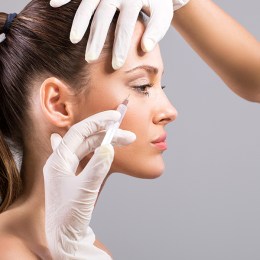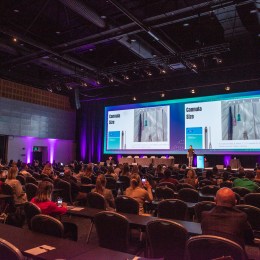If you’re considering going into the tattoo removal industry, one thing’s for sure: you’ll never be short of customers.
According to Tom Godfrey, spokesperson for the consumer watchdog organisation Choice, which conducted an investigation in 2013, one in three people are now regretting their decision to get a tattoo.
Despite her superstar status, Angelina Jolie is just like anyone else when it comes to wanting rid of ink that reflects a previous relationship – one of the most significant reasons people are seeking to have tattoos removed.
Angelina had the name of her ex-husband, actor Billy Bob Thornton, imprinted on her left upper arm. But after pairing with Brad Pitt and creating a family, it was no longer relevant – or appropriate. She had the tattoo removed and replaced with lines of inscription that celebrate their six children.
“There’s no doubt that tattoos are increasing in popularity,” says Tom Godfrey. “We’re seeing them adorning sport stars, models. You just look now at the AFL players, all the cricketers – Michael Clarke, you name it – pretty much everyone in popular culture these days has a tattoo, and that’s translating to younger generations.”
But with the increasing popularity of tattoos comes the rise in demand for their removal. The reasons for this are as varied as the markings themselves. Among the most commonly cited by tattoo removalists across the professional spectrum:
- Wanting an ex-partner’s name deleted
- An image depicts a lifestyle a person no longer lives, or is at odds with their current circumstances (eg. a nursing mother with a tattooed breast)
- Misspelt words are, for obvious reasons, very unpopular, as is simply shoddy work (including by cosmetic tattooists on areas like lips, eyelids and eyebrows).
- Some people who once regarded their inking as a form of rebellion against society are now dismayed to find they have become part of the tattooed mainstream.
- There’s the “it seemed a good idea at the time …” kind of regret after a flight of fancy or pressure from peers.
- And then there are the folk who simply don’t like their tattoos anymore.
As regulations governing the use of lasers and IPLs are reviewed by The Australian Radiation Protection and Nuclear Safety Agency (ARPANSA), it is more important than ever that salon, spa or clinic owners and their therapists already performing treatments or contemplating buying equipment fully understand what comes with the territory.
The safety and satisfaction of customers is the paramount consideration, so there’s high risk of significant backlash against you if something goes wrong. You could also find yourself hoodwinked financially by unethical distributors of dodgy devices – or by buying inferior machines from outlets such as eBay or second hand from other practitioners, without due diligence.
“Clients want to know that the person removing the tattoo has been trained appropriately and can ensure that the technology being used is not going to cause more damage than actually having the tattoo there in the first place,” adds Tom.
The horror stories of tattoo removal by practitioners with little or no training, experience or understanding of the equipment are legion.
Lasers are exceptionally powerful tools and, in the wrong hands, can be powerfully dangerous: causing burns with subsequent scarring and, if a laser hits the eye because no protective eyewear is in place, even blindness. The latter applies to both practitioner and client.
Widespread use of cheaper knock-off versions of Q-switched lasers and use of IPL devices – the latter are not designed for tattoo removal* – are principal causes of injury and unsuccessful results.
In the meantime, knowledge, education and training are your greatest allies in the tattoo removal business.
TATTOO REMOVAL TERMINOLOGY
Removal techniques have come a long way since the days of skin grafting, using topical and injectable acid therapies or infrared and other non-medical lasers.
Best practice nowadays dictates that unwanted tattoos be gradually broken apart through the use of picosecond or Q-switched lasers set to specific wavelengths, depending on skin type and the colour and location of the tattoo.
New-generation picosecond lasers have extremely short pulse durations (750 trillionths of a second) that achieve a very high peak power and can focus that energy onto a small volume of space in order to ablate material from the surface quickly and cleanly without damaging the underlying areas.
Picosecond devices work in two ways: first, the mechanical or acoustic effect simply breaks up the pigment; and second is a thermal effect. When the energy is absorbed it induces heat, which also plays a part.
The tattoo ink (or pigmentation, as it is now being applied to) is then absorbed and eliminated by the body’s natural processes.
Q-switched lasers generate a short pulse – in the nanosecond (one thousand-millionth of a second) range – exploding the particles of tattoo ink into dust that the body’s immune system can then remove. “Q-switch” means the laser can be switched from 1064nm (nanometres) to 532nm by a simple lens change. The 1064nm wavelength is ideal for black, blue and purple while the 532nm lens is used for lighter colours like red, pink and orange. The QS is a true tattoo removal laser.
Depending on the device, generally only one layer of ink can be reduced at a time so a course of 4-10 treatments is required for complete removal. Other factors, such as the age of the tattoo and the type of ink used, also affects the number of treatments required.
The key laser tattoo removal machines available in Australia are known as Class 4 Lasers and are usually limited to doctor-operated practices and clinics.
“Only Class 4 lasers will effectively remove a tattoo and the risk of scarring is greater if not using one,” according to Josh Locker, CEO of Cryomed.
“The power of the individual unit only has impact on the treatment speed – that is, the lower power machine has to focus its power into a smaller spot to get an effective result.”
This is one of the greatest risk factors, if the operator was to go from 10mm spot size to 5mm spot size and the power not adjust, the patient would get four times the dosage.
BUYING EQUIPMENT
Do your research when looking to invest in a tattoo removal machine, especially in regards to the supplier.
Similar to a number of different industries and products there are varying degrees of quality on the market. It is important to be wary of cheap machines because these may actually cost you more long term.
Ensure that the developer or supplier has been in business for an extended period of time – ten plus years – and that they not only provide a top quality machine but also provide expert training, marketing support, technical support, after-sales service and ongoing training support.’
Industry experts advise to only invest in laser and IPL equipment that has the CE Mark (Declaration of Manufacturers Conformity) and ideally is also TGA approved to ensure your equipment is safe, fit for its indicated purpose and “future-proof” in the event of new Federal regulations.
THE LAY OF THE LAND
Few people realise that all laser operators in Australia are required to comply with the Australian Laser Standard: AS/NZ 4173:2004 (Guide to the safe use of lasers in health care).
Currently regulations, restrictions and enforcement on the use of Class 4 lasers are on a state by state basis, as follows:
WHO CAN DO WHAT, WHERE
The regulatory bodies around Australia and the rules they impose are:
Queensland: Radiation Health, Health Protection Unit, Queensland Health. Queensland allows for certain Class 4 lasers to be used by suitably trained nurses and therapists for treatments such as hair and tattoo removal, but restrict surgical and fully ablative systems such as C02 lasers to physicians only. There is also an imperative to have 100 hours of practical experience with lasers before being allowed to practice independently. This has meant many practitioners moving interstate for a period, where there are more opportunities to clock up the hours.
Tasmania: Radiation Protection Unit, Department go Health and Human Services. The unit has also proposed new rules and licensing around what Intense Pulsed Light (IPL) devices can be used, and how it should be used.
Western Australia: Radiological Council, Department of Health. There is a blanket ban on the use of Class 4 therapeutic lasers for all people other than suitably licensed medical practitioners. This effectively removes Class 4 lasers from the reach of the typical industry operators who perform the bulk of treatments such as laser hair removal and tattoo removal. Since there is no restriction on IPL devices in WA, this has led to devices being used to perform treatments that they may or may not be perfectly suited – such as IPL for tattoo removal. A cheap, unregulated IPL imported from China or a poorly-trained therapist with a high-powered IPL may cause as much or more damage to a client than a well-trained laser therapists using a high-quality laser device.
Victoria: Nil
South Australia: Nil
NSW: Nil
ARPANSA, the Federal body tasked with creating nationwide guidelines and standards for best has yet to formulate new guidelines, standards or legislation. High profile doctors and indeed reputable device companies are all hoping this will soon change, with the instigation of a uniform and logical guidelines and legislation to help regulate the industry, ensure higher safety standards, a restriction on the importation of devices that do not meet international safety standards and mandatory training for laser and IPL therapists.
“We advise all doctors, nurses and therapists to attend a comprehensive and accredited laser safety training course before investing or using any laser or IPL device,” says Josh Locker. “You wouldn’t attempt to fly a light aircraft without lessons, why should using a class IV laser be any different?.”
WHY NOT IPL?
“IPL (Intense Pulsed Light) machines function in milliseconds instead of nanoseconds,” says Melbourne dermatologist Dr Phil Bekhor. ‘The wavelength is too broad. They’re marketed as an all-purpose machine, including tattoo removal, but shouldn’t be used for that purpose. They often cause distorting of the tattoo and horrific burns and scars.”
Hilary Quinn, proprietor of Tattoo Removal in Melbourne, adds: “IPL shoots a block of light of about 2x6cm rather than the 5-8mm pinpricks of Q-switched lasers. It’s like trying to crack an egg with a machine gun.”
LATEST ON THE BLOCK
In the past couple of years alone there have been significant breakthroughs in tattoo removal technology; devices that can variously remove all tattoo ink colours (as opposed to only a few), shorten individual treatment times (and the number required), thus the overall rate at which tattoos can be dramatically reduced or even removed completely:
Enlighten from Cutera is a 1064nm/532nm picosecond laser that was launched in Australia in late 2014 for tattoo removal but has since proved highly effective in treating pigmentation. “In the past six months we have been using enlighten to go after pigmentation – particularly the very stubborn melasma – with very encouraging results,” says Dr Rick Green, a Canadian plastic surgeon who visited Australia for the Non-Surgical Symposium in June and conducted training workshops on behalf of Cutera around the country. “A bonus is we can use it on all six Fitzpatrick skin types. It has the ability to deliver energy pulses very quickly (750 trillionths of a second) which allows it to break down very fine pigmentation so that the body can absorb it. We use this to our advantage in tattoo removal, but it is helping in this challenging situation as well. The prospects are very exciting.”
PicoSure from Cynosure, a picosecond device,”is much quicker than traditional tattoo removal machines, causing a lot less discomfort for the patient and with a lot less treatments. The lower energies used also means less change of scarring,’ says Dr Gabrielle Caswell, Past President of the Cosmetic Physicians College of Australasia (CPCA) and who runs Eyra cosmedical clinics in country NSW. “PicoSure can also manage recalcitrant and stubborn tattoos and those of all colours. This means that it is a one-stop treatment for patients. Using light and sound energy, it smashes the tattoo ink into smaller fragments. This makes it easier for the immune system to gobble up the ink and remove it from the skin. Traditional tattoo removal uses only light, which will break ink down from ‘pebbles’ to sand, whereas Picosure will break the ink into fine dust.”
Pastelle from Cryomed “has streamlined the production of the laser beam,” says Josh Locker. “Up until now the Q-switching process is a complicated set-up and is the standard of other Q-switched lasers. Pastelle’s clever engineering means that the laser unit is stable, almost maintenance-free and cheaper for the end-user. The twin-pulse ensures that there is no excessive energy delivered per pulse, which is a cause of burns and other unwanted laser complications.”
Deka Duloite Q-Switched Nd:YAG from High Tech Laser has dual wavelength technology – 532nm (green) and 1064 nm (infrared) – to target a large number of tattoo colours. It is also applicable for treatment of darker skin types (1064 nm). Very short pulse duration (6ns) with very high peak power makes for efficient treatment with less side effects.
There’s no doubt that laser technology is evolving year on year – soon tattoos may be almost as quick to put on and take off as jewellery!
But it’s important to be aware that the user landscape could soon change – so do your homework before making any investment in equipment. If you are already in the removal business, it would be wise to check you are operating according to the national guidelines.
Be sure to research devices and suppliers carefully and ask as many questions as you need to. Anyone who doesn’t want to make you feel comfortable in your investment is probably not the person you want to put your trust into, just as you wouldn’t expect your clients to jump into a treatment without getting all the answers that they need from you.
If it is for you, the tattoo removal business could help you power ahead with profits and customer service. With the right planning it will put you in the black, not the red!




